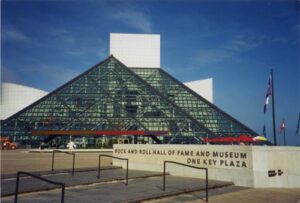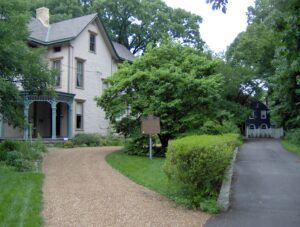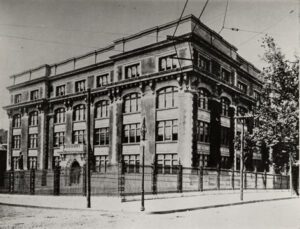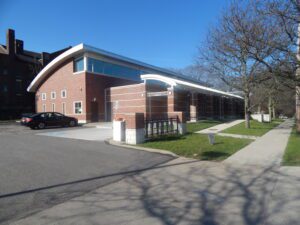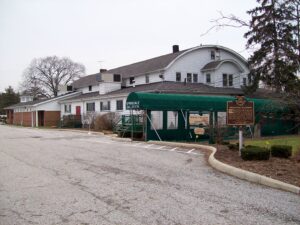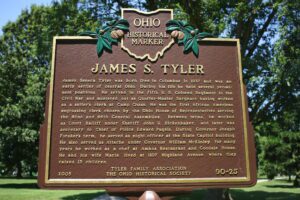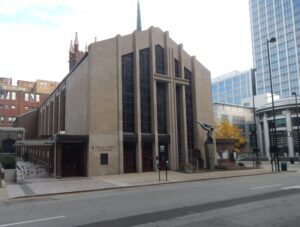, OH
The Hines Farm Blues Club started on this site in 1949 as a party in Frank and Sarah Hines’s basement. The Club grew to become one of Ohio’s premiere blues and rhythm & blues venues until closing in 1976. A virtual “Who’s Who of African-American Artists” played here, first in a picnic shelter in the woods and then in the main building, erected in 1956. “Mr. Luke’s Outdoor Pavilion” that doubled as a skating rink was the last major addition. Holding as many as a thousand fans, Count Basie and his entire orchestra marked its opening with a performance under the stars in August 1961. Bobo Jenkins, Little Esther Phillips, B.B. King, Jimmy Reed, Buddy Lamp, and John Lee Hooker were among the musical greats who played Hines Farm. Important local blues artists Big Jack Reynolds, Curtis Grant, and the Griswold Brothers were regulars as well. (continued on other side)
, OH
When radio station WJW disc jockey Alan Freed (1921-1965) used the term “rock and roll” to describe the uptempo black rhythm and blues records he played beginning in 1951, he named a new genre of popular music that appealed to audiences on both sides of 1950s American racial boundaries–and dominated American culture for the rest of the 20th century. The popularity of Freed’s nightly “Moon Dog House Rock and Roll Party” radio show encouraged him to organize the Moondog Coronation Ball–the first rock concert. Held at the Cleveland Arena on March 21, 1952, the oversold show was beset by a riot during the first set. Freed, a charter inductee into the Rock and Roll Hall of Fame, moved to WINS in New York City in 1954 and continued to promote rock music through radio, television, movies, and live performances.
, OH
Dr. Winthrop Smith Sterling (1859-1943) founded Mu Phi Epsilon International Professional Music Fraternity on November 13, 1903, at the Metropolitan School of Music in Cincinnati, where he served as dean. The Victorian frame house was built by his parents, Samuel Gano and Eliza Smith Sterling in 1867, and was home to Sterling family members until the early 1940s. A highly respected organist and university teacher, Dr. Sterling taught piano and organ in this home in which he had installed a 12-foot hydraulic pump organ in the “music room.”
, OH
William and Abigail Cutter Woodward founded Woodward High School, the first public high school west of the Allegheny Mountains, on this site October 24, 1831. Concerned that the poor of Cincinnati had no avenues for education, the Woodwards donated land, time, funding, and expertise to this venture that brought the arts and sciences to “those who have not the means of procuring such advantages themselves.” Notables include Dr. Joseph Ray, principal, 1851-1855, author of several popular mathematics texts; Professor William McGuffey, author of the well-known readers and spellers; and William Howard Taft, Class of 1874, former U.S. President. From 1856-1863, the home of Levi and Catherine Coffin was also located on this site. Both were legendary abolitionishts who helped enslaved people escape to freedom in Canada. Levi is often referred to as the “President of the Underground Railroad.”
, OH
One of the most recognized figures of the Harlem Renaissance, Langston Hughes was born in Joplin, Missouri on February 1, 1902 and moved to Cleveland by the time he was in high school. An avid traveler, he credited his years at Central High School for the inspiration to write and dream. The consummate Renaissance man, Hughes incorporated his love of theater, music, poetry, and literature in his writings. As an activist, he wrote about the racial politics and culture of his day. He was awarded the Spingarn Medal by the NAACP. He published over 40 books, for children and adults. Known as the “Poet Laureate of the Negro People,” Hughes most famous poem is “The Negro Speaks of Rivers.” Langston died on May 22, 1967, and his remains were interred beneath the commemoratively designed “I’ve Known Rivers” tile floor in the Schomburg Center for Research in Black Culture in Harlem.
, OH
Springvale Ballroom is located on part of the one hundred and forty acre tract that English immigrant John Biddulph bought in 1840. Fred Biddulph, John Biddulph’s grandson, was born near this site in 1887. Fred and his wife, Clara, built the five thousand square foot Springvale Ballroom. On May 19, 1923, they paid fifteen dollars for the right to open the dancing pavilion. The first dance at Springvale Ballroom was held on May 23rd. A five hole golf course was added to the property in 1928. Later changes to Springvale included renovation of the ballroom, the addition of a golf office, and an upgrade to a full eighteen hole course.
, OH
James Seneca Tyler was born free in Columbus in 1837 and was an early settler of central Ohio. During his life he held several prominent positions. He served in the Fifth U.S. Colored Regiment in the Civil War and mustered out as Quarter-Master Sergeant having worked as a sutler’s clerk at Camp Chase. He was the first African American engrossing clerk chosen by the Ohio House of Representatives serving the 62nd and 66th General Assemblies. Between terms, he worked as Court Bailiff under Sheriff John U. Rickenbaker, and later was secretary to Chief of Police Edward Pagels. During Governor Joseph Foraker’s term, he served as night officer at the State Capitol building. He also served as Attache under Governor William McKinley. For many years he worked as a chef at Ambos Restaurant and Goodale House. He and his wife Maria lived at 1107 Highland Avenue where they raised 13 children.
, OH
In 1817 twenty-two men, including future President William Henry Harrison, chartered Cincinnati’s first Episcopal parish, Christ Church. In 1835 members erected a Gothic Revival-style church on this site. The neighborhood evolved as the city grew with the influx of immigrants. Parish women raised funds to teach, feed, clothe, and shelter tenement families, and alleviate suffering during floods and disease outbreaks. In 1883 the women helped establish what became Cincinnati Children’s Hospital. In 1909 members opened the Late Gothic-style Parish House, a community center with kitchen, classrooms, library, auditorium, clinic, gymnasium, and bowling alley. By the parish’s centennial in 1917, music had expanded beyond worship to public concerts. In 1940 the annual Boar’s Head Festival of music and pageantry began. Since the 1960s, members have collaborated with local agencies to advocate for social and economic justice, a mission continuing into the 21st century. (Continued on other side)



